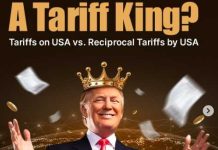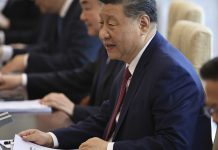Summary & Analysis of March 2025 Beige Book Compared to January 2025
The March 2025 Beige Book reveals a slight weakening in economic momentum, with consumer spending slowing, tariff concerns rising, and price pressures re-accelerating—all in contrast to the modest growth outlook seen in January. Labor market tightness is easing, but wages and price growth remain elevated, creating a stagflationary undertone. The impact of Trump’s 25% tariffs is beginning to be felt, and businesses are increasingly uncertain about trade and fiscal policy.
Key Trends & Shifts from January to March
| Category | January 2025 Summary | March 2025 Summary | Trend |
|---|---|---|---|
| Overall Activity | Slight-to-moderate growth, solid holiday spending. | Slight growth overall, but 6 regions stagnant, 2 contracting. |  Weaker growth Weaker growth |
| Consumer Spending | Moderate growth, strong holiday sales. | Lower spending, especially on discretionary goods. |  Spending slowdown Spending slowdown |
| Manufacturing | Slight decline, stockpiling ahead of tariffs. | Slight-to-modest increases, but tariff worries are rising. |  Modest recovery but uncertainty growing Modest recovery but uncertainty growing |
| Construction & Real Estate | Mixed housing market; nonresidential weak. | Both residential and commercial construction weakened. |  Weaker activity Weaker activity |
| Agriculture | Weak conditions, weather struggles. | Deteriorating, with worsening farm income outlook. |  Further weakening Further weakening |
| Labor Market | Job growth in healthcare & finance; manufacturing flat. | Healthcare & finance still hiring, but manufacturing & IT layoffs growing. |  Signs of labor market slowing Signs of labor market slowing |
| Wages | Moderate pace, slight easing in wage pressures. | Still modest-to-moderate, but slowing further. |  Cooling wage growth Cooling wage growth |
| Prices & Inflation | Prices rising modestly, but tariffs could push inflation higher. | Prices rising at a faster pace, firms preemptively raising prices. |  Stronger inflation pressures Stronger inflation pressures |
| Business Sentiment | More optimism than pessimism about 2025. | Uncertainty is rising, particularly about tariffs. |  Declining optimism Declining optimism |
Key Takeaways from the March 2025 Beige Book
1. Growth Momentum is Slowing
- January Beige Book painted a picture of modest growth across most districts, supported by strong holiday spending.
- March Beige Book now reports six districts with no growth and two with slight contractions.
- Consumer spending has weakened, particularly for discretionary goods.
- Manufacturing is stabilizing, but construction and agriculture are worsening.

2. Consumer Spending is Weakening
- In January, consumer spending rose moderately, driven by strong holiday sales.
- March reports a pullback, with lower-income consumers becoming more price-sensitive.
- Essential goods are still in demand, but discretionary spending is declining.

3. Tariff Concerns are Growing
- In January, manufacturers were stockpiling in anticipation of tariffs.
- By March, firms are already raising prices in response to new trade policies.
- Construction firms are worried about tariffs increasing material costs (e.g., lumber, steel, and petrochemicals).
- Manufacturers from multiple industries (office equipment, chemicals, auto parts) are concerned about supply chain disruptions.

4. Inflation Pressures are Rising Again
- January: Price increases were modest overall, but businesses warned tariffs could be inflationary.
- March: Inflation is rising faster than before, with businesses struggling to pass on costs.
- Food inflation is worsening due to higher input costs for restaurants and food processors.
- Insurance and freight costs are increasing, adding to input price pressures.

5. Labor Market is Softening, but Not Crashing
- In January, job growth was steady, with hiring in healthcare & finance.
- By March, employment is still slightly increasing, but manufacturing and IT layoffs are growing.
- Wages are still rising but at a slower pace.
- Businesses are uncertain about hiring, partly due to immigration policy uncertainty.

Fed Policy Implications & 2025 Economic Outlook
1. Tariffs Will Be a Major Headwind
- A 25% tariff on imports means inflation will rise, and growth will slow.
- The Fed was already cautious about inflation—this makes rate cuts even less likely in the near term.
- Higher input costs will hurt construction, manufacturing, and retail.

2. The Fed May Delay Rate Cuts Even Further
- January Beige Book suggested modest inflation and the potential for rate cuts in mid-2025.
- March Beige Book suggests inflation is picking up again due to tariffs.
- With core inflation creeping back up, the Fed may not cut rates until late 2025—or even 2026.

3. Business & Consumer Confidence is Weakening
- January: Businesses were optimistic about 2025.
- March: Businesses are more uncertain about tariffs, trade policy, and the economy.
- Consumers are pulling back due to inflationary pressures.

4. Real Estate & Construction Are Under Pressure
- Higher costs for materials due to tariffs will squeeze margins.
- Residential & commercial real estate are already weak, and now construction is slowing further.

Final Outlook: More Uncertainty, Higher Inflation, Slower Growth
| Factor | January Take | March Update | Market Impact |
|---|---|---|---|
| Economic Growth | Slight-to-moderate growth | Weaker growth, 6 districts stagnant | Bearish |
| Consumer Spending | Moderate growth | Declining discretionary spending | Bearish |
| Inflation | Moderate, but risks ahead | Accelerating due to tariffs | Hawkish |
| Interest Rate Cuts | Mid-2025 likely | Possibly late 2025 or later | Hawkish |
| Labor Market | Steady, with wage gains | Softening, layoffs growing | Mixed |
| Tariffs | Potential risk | Now impacting costs & confidence | Inflationary |
| Business Confidence | Optimistic outlook | Growing uncertainty | Bearish |
Conclusion: Markets Are Too Optimistic—The Fed Is Not Cutting Anytime Soon
- Higher tariffs = higher costs = inflation stays elevated.
- Business investment will slow due to uncertainty.
- Consumer spending is weakening—this could drive slower GDP growth.
- The Fed will need to see inflation cool before cutting rates, which may take longer than expected.








